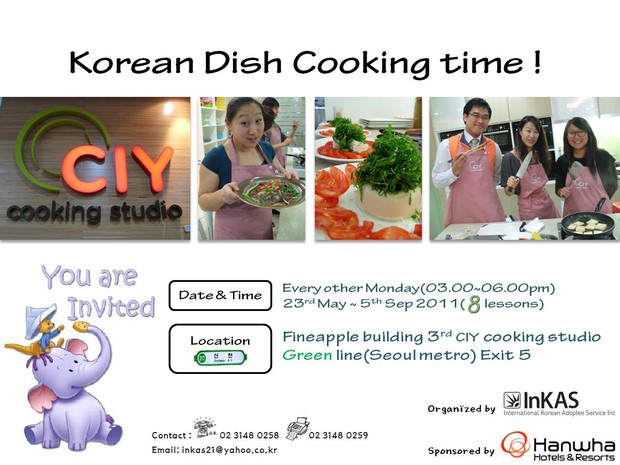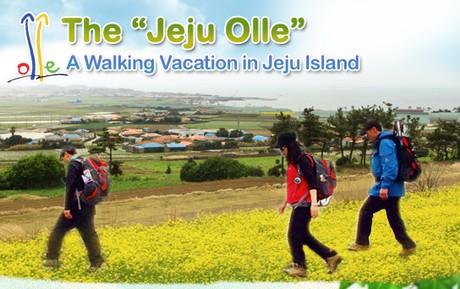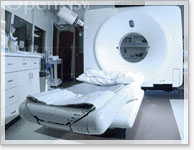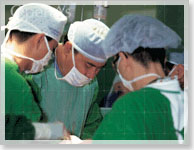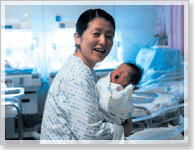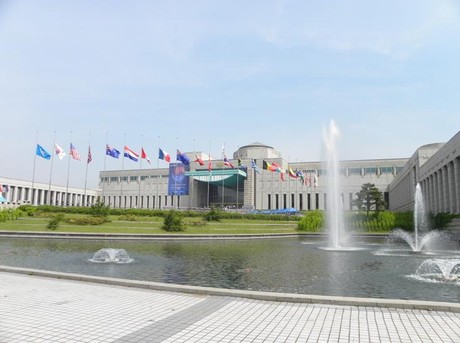The seonbi spirit
When you are tired of apartment buildings, shopping centers, and even traditional markets, it is always lovely to stroll around some of the oldest parts of Seoul. There are sites here that stretch back into the past and connect the city's present with the endless stream of life that has flowed through this place for millennia. The grandest of all Seoul's palaces, the Gyeongbokgung Palace compound, is so massive that you can never see it all in one visit. Its accessibility and cheap entry price make it worth revisiting at least once a season; every trip is bound to yield some new delights. Construction on the palace began in 1934, after Seoul was chosen as the capital of the Joseon Dynasty. During the Japanese colonial period (1910-1945), more than half the existing buildings were destroyed. However, many of the more majestic structures still stand or have been reconstructed. The traditional changing of the guard ceremonies are recreated several times each day before the imposing Gwanghwamun Gate, whose reconstruction was completed just last August. On top of its countless treasures to be discovered, the palace compound also houses the National Palace Museum of Korea and the National Folk Museum of Korea.
Where to Eat
There is a little alley running perpendicular to the western outer wall of Gyeongbokgung compound that has some very tasty and affordable Korean restaurants - Saemaeul-Sikdang, a kimchi jjigae specialty house, and a place famous for its broiled fish. Just come out of the west gate ad go down the alley almost directly across the road.
Getting There
Gyeongbokgung Station Line 3, Exit 5. Or, for a scenic route, come out of Gwanghwamun Station, Exit 5, to Gwanghwamun Plaza and walk all the way up to the main gate of the palace.
All-Inclusive Ticket
An all-inclusive ticket (10,000 won, valid for 1 month) for Seoul's four major palaces (Gyeongbokgung, Changdeokgung, Changgyeonggung, and Deoksugung) and Jongmyo Shrine is available at the ticket offices of all these five destinations.
More Info
Website: www.royalpalace.go.krT. (02) 723-4283. Closed every Tuesday. Open 9am-6pm (Mar-Oct) and 9am-5pm (Nov-Feb). Open until 7pm on weekends and national holidays (May-Aug). Admission 3,000 won for adults, 1,500 won for children. Free guided tours (about one hour) are available from inside the gate where you show your ticket. Call ahead for groups of 10 or more.
The most accessible of old Seoul's gates
Seoul was once a citadel, a city surrounded by 18 kilometers of wall. Four large and four small gates provided access to the nation's capital. Of the four large gates in each of the cardinal directions, only those in the north and east stand unscathed (the west gate is gone, and the south gate was damaged by arson in 2008). Dongdaemun ("the great east gate") is known as Heunginjimun, literally "gate of rising benevolence." The first gate was built in 1396 during the reign of King Taejo, the first monarch of the Joseon Dynasty. The portal currently standing was built in 1869. The neighborhood is now better known for the fashion shopping district that sprang up just nearby, but the gate is unmissable, sitting incongruously at the intersection of some of Seoul's busier streets. The gate itself is not usually open to public access, but it is possible to navigate your way around it and admire the centuries-old walls partly overgrown with ivy. Just north of the gate is part of the old city wall, demolished to allow for the city's expanding girth. Some of it was used to build what followed - a church just opposite the gate sits upon the wall's foundations. You can hike along the wall up to Mt. Naksan Park. South of the gate, at Dongdaemun History and Culture Park, another section of the wall has recently been restored and is now open to the public.
Where to Eat
Try the street food tents just across from the fashion market, south of the gate. There are lots of cheap and tasty eats there, and the atmosphere is convivial, especially at night.
Getting There
Dongdaemun Station, Lines 1&4, Exit 6. To find the remnants of the old city wall, take the road immediately north of the gate, to the right of one church and leading toward another church. Look for the path that comes off to the left.
Where ancestral music is still played
Jongmyo is the royal shrine of the Joseon Dynasty. Here, nineteen kings and thirty of their wives are memorialized. Their bodies are not here - just their name tablets. It is these stone tablets that were the objects of Confucian rituals of ancestor reverence. Jongmyo was built in 1934, the same year as Gyeongbokgung. Over the years, the shrine was extended to accommodate more deceased kings and their consorts. The entire complex was rebuilt in 1601 after being burnt down by Japanese invaders. A beautiful tradition of music and dance developed in the rite, which is still held on the first Sunday of each May, called the Jongmyo Jerye. Performers dressed as royal servants play court music, Jerye-ak, and the late monarchs of Korea are venerated. This music and rite were recognized in 2001 as the first of Korea's Masterpieces of the Oral and Intangible Heritage of Humanity by UNESCO. Other ceremonies and performances are held there five times a year. Even on a non-ceremonial day, Jongmyo is impressive as the longest building ever built in the traditional Korean style, facing a massive courtyard measuring 100 by 150 meters. It was added to UNESCO's World Heritage list in 1995.
More info
On weekdays and Sundays (except Tuesdays, when it is closed), admission to Jongmyo is only allowed for guided tours. English tours are at 10am and 11am, and at 2pm and 3pm. Call (02) 765-0195 to reserve a place, or have a Korean friend do it on the website. Every Saturday, it is open to visitors without guided tours. Opening hours are 9am-6pm (Mar-Sept) and 9am-5:30pm (Oct-Feb). Entry costs 1,000 won for adults and 500 won for children. Website: http://jm.cha.go.kr
Places to eat
Try the handmade noodles (kalguksu) or dumpling soup (manduguk) in the small restaurant above the pharmacy (cheerfully labeled "Have a healthy day") outside Exit 8 of Jongno 3-ga Station.
Getting There
Jongmyo is within five minutes' walk of Jongno 3-ga Station. From Line 1, take Exit 11 (walk straight and take the first road to the left); from Line 3 or 5, take Exit 8 (walk straight and then follow the road to the right).
Jeong-dong - where the east first met west
This quiet street, running from the side wall of Deoksugung Palace up to where Seodaemun, the Great West Gate, once stood, still resonates with the history of early modern Korea. Many of Seoul's first encounters with Wester education, medicine, diplomacy, imperialism, and religion took place here on the western edge of the walled city. It was at the former Russian Legation that the penultimate Joseon monarch, King Gojong, spent a year after his wife, Queen Min, was assassinated. Nearby, the first western-style hotel in Seoul, the Sontag Hotel, was built. The beautiful Jungmyeongjeon, recently restored, was once the King's library and part of Deoksugung before becoming a banquet hall, then the location of the treaty that made Korea a Japanese protectorate, and later on the foreigners-only Seoul Club. In this neighborhood, you will also find Korea's oldest Protestant churches, the U.S. Embassy residence, the first girls' high school in Korea, and much more. There is an abundance of charming places to eat and stop for a coffee along the way.
More Info
For a more informative walk, follow Tour 2 of "Seoul's Historic Walks" by Chou Insouk and Robert Koehler.
Where to Eat
Since you are in Jeong-dong, it makes sense to try some foreign food. The Brazilians may not have been there in 1900, but they have a restaurant there now called Ipanema, serving all-you-can-eat Brazilian barbecue. Opposite the Canadian Embassy and up the hill a little.
Getting There
The neighborhood of Jeong-dong can be reached on foot from City Hall Station, Lines 1&2. Take exit 1, turn 180 degrees, and take the first left turn. Follow the wall of Deoksugung Palace along to the roundabout and take the middle road.
-The article courtesy of Seoul magazine
http://english.visitkorea.or.kr/enu/SI/SI_EN_3_6.jsp?gotoPage=14&cid=1134708&out_service=
